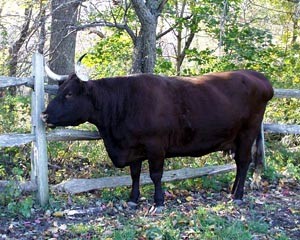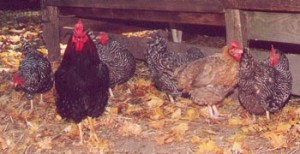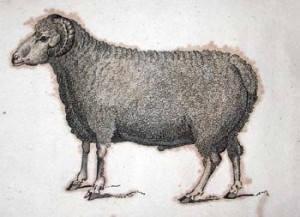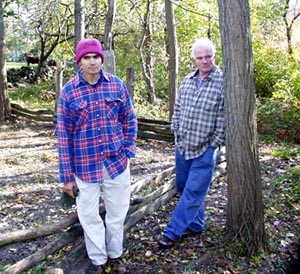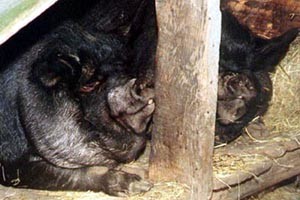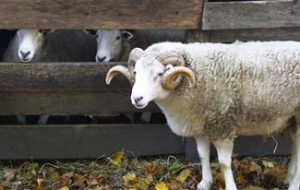Part I
The farm staff at Plimoth Plantation agonized over what to do. A main attraction of the living history museum is its assortment of heritage animals–cows, goats, and pigs painstakingly bred to resemble their seventeenth-century ancestors. But the rapid spread of foot-and-mouth disease among cloven-hoofed animals across the Atlantic presented a terrible threat. At the start of the English outbreak in February 2001, a dozen farms a day were reported to be infected; soon the number climbed to fifty. Up to ten percent of the visitors to Plimoth Plantation come from Great Britain, and many of them arrive within a day or two of landing at Boston’s Logan International Airport. The aphthovirus that caused the disease can live for thirty days and can be spread through the air–a sneeze will do the job nicely–or tracked in on shoes. When members of the plantation staff considered their situation in light of the ironclad agricultural policy in force both in the United States and in England, which calls for eradicating livestock known to have been exposed to foot-and-mouth, few options presented themselves. So in late March, just days before Plimoth Plantation’s village of 1627 was to come to life for the 2001 season, the museum’s 130 head of livestock were rounded up and removed to a modern breeding barn at the back of the property. Over the next few weeks, many of the animals were transported to foster farms in Massachusetts, New Hampshire, and Vermont, where they would remain safely tucked away until the threat had abated.
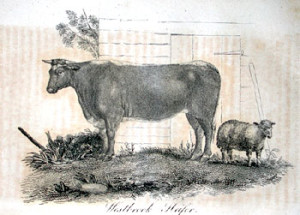
A few hundred miles to the south, the granddaddy of living history museums was in a similar quandary. Colonial Williamsburg, which is modeled on life in Virginia during the decade leading up to the American Revolution, is a community with full-time inhabitants who need to come and go at will. Its cows, sheep, and horses are fenced in, but they often greet visitors. Colonial Williamsburg’s overseers decided there was no practical way to control contact between animals and people, and they held their collective breath. Much the same strategy prevailed at Old Sturbridge Village, which depicts life in an agrarian community of 1830. The village, in Massachusetts just north of the Connecticut border, has two farms, one typical of a family of middling means and another representing the circumstances of a wealthy landowner. Over the years, the museum has moved toward providing a hands-on experience with the animals, and some visitors have even watched its ewes give birth to their young. “This year, with foot-and-mouth, we asked them not to touch the animals,” explained Rich Pavlick, who serves as project coordinator for agriculture. “Ninety-nine percent of the visitors were very understanding. One or two people were a little bit annoyed.”
Was the hand wringing really necessary? It is hard to argue the fears were misplaced. In the last quarter century, heritage animal breeding has transformed living history museums and challenged both the public and historians to reconsider colonial Americans’ animal world.
Part II No such thing as overkill
Although foot-and-mouth disease has remained common in large regions of the world, last year’s outbreak in England presented the significant possibility that the virus would reach these shores. And those familiar with several decades of efforts to save heritage breeds from extinction would aver that no amount of caution–especially in the museums that have been in the forefront of the movement–could be called overkill. Indeed, in certain circles, talk of the Wiltshire sheep, with its gracious, curved horns, or the Milking Red Devon cow, with its deep color and gentle nature, is just as passionate as wildlife advocates’ discussions of the peregrine falcon or the snow leopard. Farmers, scientists, historians, educators, and conservationists are banding together in the campaign to preserve as many as one hundred breeds of domesticated animals that were once as common as corn in August but are now perilously close to disappearing from our world.
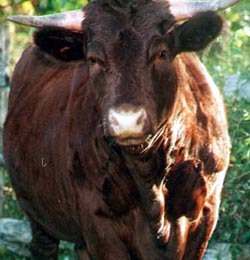
The extent of what was at stake when foot-and-mouth emerged this past spring can be taken as a testament to the preservationists’ success. As recently as the mid-1980s, when Plimoth embarked on its quest for animals that would reflect the qualities of their colonial counterparts, there was a fair share of skepticism about saving rare breeds. Yet today it is acknowledged that the accomplishments of the conservationists and their colleagues in the labs could be important to the safety of commercial livestock. In many instances, the gene pools of cattle, pigs, and sheep have been diminished as farmers have bred their stock with the sole aim of increasing productivity. This has resulted in compromised immune systems. If a commercial breed were to be hit by a devastating epizootic disease, the genes of a hardy rare breed could be used to help re-establish the immunity of a commercial one. At the Tufts University School of Veterinary Medicine, scientists are looking into establishing a repository to hold semen, embryos, and cells for future studies. “I want enough genetic diversity in the library so that a whole breed could be revived at the same time,” said Dr. George Saperstein, a livestock veterinarian.
When Plimoth launched its search for breed documentation in 1986, researchers found little to work with; early settlers had left few specifics behind about the livestock that accompanied them from England and the Netherlands. What did exist were sketches in documents concerning the “division of cattle” in May of 1627, which ended the colony’s holding of livestock in common. The animals were described as “two black cows, a red cow, a white backt cow and four black heifers.” The Kerry cow, an ancient English dairy breed, and the Milking Red Devon were tapped to represent their black and red forebears. The plantation’s staff found that the Kerry was a near match for a black cow described by seventeenth-century British livestock authority Gervase Markham, who wrote that it had “hair like velvet, large white horns with black tips,” and added, “They are of stately shape, bigge, round, and well buckled together in every member, short joynted, and most comely to the eyes.” Sheep and hogs presented an even bigger challenge. The Wiltshire Horn sheep of colonial days was smaller and hardier than the modern type, which has been developed as a hefty meat producer with little or no fleece. Getting the right look, or phenotype, meant using more than one breed. The farming staff crossed the Wiltshire with the Dorset Horn, a small breed with a heavy wool coat. On the swine front, the Tamworth hog, a reddish-colored lean and hardy forager, was crossed with a European boar to produce the Iron-Age pig, which is covered in coarse hair and is one-third the size of its normal domestic counterpart. While farm records of the period contain little information about goats, they were a primary source of milk and meat for early settlers. To represent this tough little animal, Plimoth has imported and bred the Arapawa Island goat of New Zealand, an endangered breed that most closely resembles the now extinct Old English Milch goat.
But Plimoth wanted its breeding program to be more than fleece deep. “In our quest for the most accurate recreation of a seventeenth-century type,” the farm staff wrote in 1993, “we must not lose sight of the importance of maintaining the genetic material found in these older breeds.” There is little question that the Kerry and Milking Red Devon were–and still are–in dire need of saving. The American Livestock Breeds Conservancy, a nonprofit group that strives to protect historic lines from extinction, rates each as “critical,” with fewer than two thousand animals alive. The sheep are better off–but not by much. The Wiltshire is termed “rare,” with fewer than five thousand in existence, and the Dorset, with twice as many alive, is in the “watch” category. As a result, the farm staff has devised a program in which the two breeds are crossed for looks and also are maintained independently in order to preserve their genotype. The same is true of the “rare” Tamworth pig and the European boar.
Plimoth’s program aggressively attempts to marry historical accuracy with the concerns of preservation. Other institutions have chosen simpler paths. Although Colonial Williamsburg has had domesticated animals since its founding in 1926, farm manager Elaine Shirley said the museum did not worry much about whether the animals were close cousins to their ancestors. When Williamsburg launched its rare breed program sixteen years ago, it had one thing in mind: preserving genetic diversity. In focusing on genotype, rather than phenotype, it managed, rather serendipitously, to introduce more historically accurate breeds into its population.
Around the middle of the eighteenth century, the breeding of livestock was dramatically changed by Robert Bakewell, an English agriculturist. Until then, livestock was either of a type common to a region or of no particular description at all. Bakewell bucked a taboo and inbred a type of sheep found in Leicestershire to accentuate certain desirable characteristics. In doing so, he hit upon the fastest way to livestock improvement and created the method of developing bloodlines that is still in use today. Bakewell bred what came to be known as the Leicester Longwool, a sheep with a barrel-shaped body, a thick coat, and high-quality meat. He went on to breed cattle and horses, and his schemes were widely publicized in English journals. Gentleman farmers in America who pored over those publications were intrigued. George Washington was among them, and he is known to have imported his own flock of Leicester Longwools. When Williamsburg launched its rare breed program, the Leicester Longwool had become extinct in this country. Once its greatest attribute, the Leicester’s long wool became its downfall. The fleece, greatly valued for hand spinning, did not work well in mechanized textile mills. At the same time, farmers raising sheep for meat began to favor well-muscled breeds that were smaller. They crossed the longwools with the smaller sheep to get a somewhat larger frame and in the process diluted the breed out of existence. Richard Nicoll, Williamsburg’s director of coach and livestock, took an interest in the Longwool, and the museum imported its original herd from Tasmania. Along with the Longwools, its program now features American Cream Draft and Canadian horses, American Milking Red Devons, and four types of chickens: Dorking, Dominique, Hamburg, and English Game Fowl.
Old Sturbridge Village, for its part, has stuck with its plan to breed animals back to the correct phenotype, rather than engage in a program that would focus on genotype. The strategy was intended to recreate the appearance of early American livestock, as opposed to increasing the number of animals whose genes matched those of rare breeds. A museum publication details nearly forty years of work, noting that cattle belonging to a typical farmer were of no identifiable breed and tended to be “red with middle-sized horns, a mixture of all breeds introduced in the colonial era.” The farm staff has crossbred Milking Red Devon, Shorthorn, Ayrshire, Guernsey, Hereford, and Lineback lines to arrive at what was once referred to as “native” cattle. In reading an article called “Barnyard Dynamics” from two decades ago, I got the impression that back breeding occasionally meant revisiting the personalities of these hardy, independent mongrels. “Some cattle are sold because they have undesirable traits,” the writer recounted. “Ruby disliked anyone with a long dress, Village milkmaids included, of course. Hannah was the athletic type who jumped fences. She was put into a jumping yoke designed to catch on the fence before the cow leaped. She jumped again, and this time took down the entire fence. She was sold soon after.”
Like Plimoth, Sturbridge has recreated the common sheep of its era by crossing the Wiltshire with the Dorset. But Salem Towne, a gentleman farmer of the early nineteenth century, whose lifestyle is depicted at the village, had little interest in such a flock. He was a progressive in his field and he kept a large herd of Merinos, which were first imported to America in 1793. A Spanish breed, the Merino had particularly fine fleece that was in great demand in the emerging New England textile industry. Because the modern type is larger and has a much heavier coat, the farm staff looked for a primitive counterpart with bare legs and dark, coarse wool; a feral breed native to Florida provided many of the unimproved Merino’s traits and was brought north.
Part III Small farm, bay view
The large museums have the advantage of deep pockets, which allow them to replicate their time periods in grand fashion, not only through their breeding programs, but also through their buildings, furnishings, equipment, and interpretive staff. Yet small museums, too, are raising heritage breeds, and in some ways may come closer to capturing the ambiance of life on an eighteenth- or early nineteenth-century farm. Tiny Coggeshall Farm in Bristol, R.I., raises Milking Red Devons, Wiltshires, and a handful of Dominique chickens, along with several “dunghill fowl,” as poultry of mixed breed were known. A short history of the museum explains, “The Coggeshall family began renting the farm in the 1830s, when Wilbur and Eliza came there to live. They were both descendants of John Coggeshall, a contemporary of Roger Williams and the first president of the Rhode Island colony. They had twelve children, some of whom lived on the farm into the twentieth century.” The farm actually represents the years predating the Coggeshalls’ arrival. Set next to Colt State Park, the forty-acre spread seems isolated, although it is not far from the main road leading into town. As I approached, I had a sense of what rural life in the Revolutionary era might have looked like. The farm is bounded on three sides by stone walls and woodland. It sits on a rise and offers a glorious view of Mill Gut, with the white-capped waters of Narragansett Bay beyond it. The day was blustery, and Luis Mendes, his red wool cap pulled down over his ears, could be seen in the distance herding five Red Devons. The sun reflected off the lustrous coats of these majestic animals as they came across a pasture enclosed by hand-split post-and-rail fencing.
Mendes has been Coggeshall’s historical interpreter for eight years, explaining to school groups and other occasional visitors that the animals provided food, fiber, and labor and were essential to a family’s existence. He and Walter Katkevich, the museum’s director, maintain the farm and carry on the breeding program. Mendes knows how to artificially inseminate the cows. “The semen comes on the Greyhound,” he remarked. The day I was at Coggeshall, thirteen sheep were in residence, mostly proud-looking Wiltshires. Several reposed beside a pen, while others peered out from between the slats. Mendes said that he and Katkevich were planning to part with either their bull calf or a steer and four or five of the sheep. I asked if the animals would be slaughtered. “I’m a vegetarian, so it makes it a little tricky,” he replied. Living history museums often find homes for the animals they cull from their herds, or they send them to petting zoos. But some are not appropriate for those situations. Ever wonder where your favorite gourmet restaurant got that delicious bit of chicken, beef, or lamb? It just might have been from a Dominique, Shorthorn, or Wiltshire.
Coggeshall also has two Guinea hogs, huge creatures with pointed ears and bristly hair. Once considered excellent for lard, they later fell out of favor, and the breed is now endangered. As his charges alternately snoozed and snorted in their specially built shed, Katkevich made note of their docile nature, but said he doubted that the farm had Guinea hogs two hundred years ago. They were brought over on slave ships and sent to the South. Bristol was a leading port for the slave trade, and Katkevich figured the hogs would show the town’s connection to that enterprise. Along with the original small red house, the farm now has two barns, a sheep pen, and several sheds. “We’re not trying to re-create an eighteenth-century farm. We represent a farm,” Katkevich said, noting that in the old days, there would have been one barn, if that, and a lean-to for the pigs. The sheep would have shared a pen with the cattle. Of course, all museums, large and small, would incur the wrath of the public–and perhaps feel the long arm of the law–if they attempted to keep animals in the exact conditions in which they existed two hundred or more years ago. Katkevich pointed out that back then, people lived with pain and early death, and livestock served a practical purpose. They were treated in ways that could not–and should not–be replicated for the sake of historical accuracy. “The oxen would die of overwork,” Katkevich said. “To be sentimental about your cattle was not realistic.”
In the colonies of the seventeenth century, domesticated animals mostly fended for themselves. They roamed free, and crops were fenced off. Calves and sheep were often picked off by wolves, though hogs were good runners, able to survive encounters with bears and rattlesnakes. As Percy Bidwell and John Falconer pointed out in their History of Agriculture in the Northern United States 1620-1860, “With such care the New England cattle early acquired through a vigorous process of natural selection a reputation for tough vitality.” Despite the harsh conditions, the numbers of livestock steadily increased, and the settlers devised a system whereby the animals grazed on common fields in the winter and early spring. When crops were in the ground, they were pastured outside of the village and tended by herders, while the working oxen, horses, and milk cows were kept nearby. Howard S. Russell, who traced three centuries of New England farming in his book A Long, Deep Furrow, noted that by the mid-1630s the town of Cambridge had set each Thursday as market day, when produce and animals were for sale. “For several years after 1635 farmers did very well, and when Stephen Daye set up his Cambridge printing press, the first booklet printed (1639) was that useful agricultural item, an almanac,” Russell wrote. Still, the farmers did little to improve conditions through the late seventeenth century and into the eighteenth. Fences were put up, but shelter and feed were lacking; during the harsh winters, snow would pile high on the animals’ backs. Oxen were used for plowing and hauling, but as they got older and slowed down, they were fattened and slaughtered for meat. During this time, farmers began to raise more sheep, in part because of government incentives seeking to reduce dependence on costly imported wool. Russell noted that in an effort to protect flocks, bounties were placed on wolves, and a dog that killed a sheep was treated as a murderer and hanged.
Even as colonists moved to protect their animals and develop markets, American Indians were finding their lives drastically altered by the introduction of cattle, pigs, and sheep into their environment. Indians subsisted according to the dictates of the season, hunting deer, moose, and beaver in the fall and winter. An Indian claimed to own an animal only at the moment it was killed. Colonists, on the other hand, took ownership of their animals and exerted total control over their lives. William Cronon, in his book Changes in the Land, wrote that the keeping of animals, combined with the raising of crops, drastically changed the New England landscape, and thus how Indians were able to live. The miles of fencing that farmers used to keep livestock from eating crops became the symbol for property ownership–and the English rationale for taking Indian lands. Moreover, the use of oxen to plow fields allowed colonists to convert acre upon acre to farmland. A system of roads cut through the countryside to bring produce to market.
It was not only the land that livestock affected. The ravenous appetites and ravages of swine, which reproduce rapidly and in great numbers, soon constituted a nuisance–and a danger–to the colonists, who exiled them to distant locations, often coastal areas and offshore islands. The animals wreaked havoc on oyster banks and other Indian shellfish gathering sites. They are said to have watched for the low water, as Indian women did, and competed directly with them for food. “Pigs thus became both the agents and the emblems for a European colonialism that was systematically reorganizing Indian ecological relationships,” Cronon wrote.
As colonists’ settlements grew, putting pressure on the ecosystem, Indians were forced to adjust to a different way of life. The white-tailed deer they had used for food and clothing largely disappeared, threatened by changes in habitat and competition from domestic animals. Cronon wrote that Indians were thus forced to live in “fixed locations on a more permanent basis. Earlier subsistence practices, which had depended on seasonal dispersal, were gradually being abandoned, with important ecological effects.” Living more closely together for longer periods of time put even greater pressure on their hunting and planting areas and encouraged the spread of infectious diseases, which were to soon take a devastating toll on their population. Alfred W. Crosby, in his 1986 book, Ecological Imperialism, summed up the situation this way: “If the Europeans had arrived in the new world . . . with twentieth-century technology in hand, but no animals, they would not have made as great a change as they did by arriving with horses, cattle, pigs, goats, sheep, asses, chickens, cats, and so forth. Because these animals are self-replicators, the efficiency and speed with which they can alter environments, even continental environments, are superior to those for any machine we have thus far devised.”
Along with their capacity for rapid reproduction, the animals arriving from Europe carried with them a variety of diseases and pests. A distemper of some sort killed hogs, and Russell told the story of a farmer named Clough who, in May 1635, found a dead one and examined its throat. Within three weeks he, too, was dead, along with three children from the area. Hog cholera was recorded in the middle of the seventeenth century, and an infectious sheep disease called “scab” later set off alarms among farmers. Bot flies killed horses, and rabies appeared for the first time in 1760, bringing death to dogs and hogs.
Change for livestock finally arrived at the start of the nineteenth century, when progressive farmers began approaching agriculture as a practical science and took an interest in Bakewell’s methods of selective breeding. In 1807, Elkanah Watson organized an agricultural fair with an exhibit of sheep under an old elm tree in Pittsfield, Mass. He believed their fleece would produce wool equal to the finest in Europe. Watson was delighted when he staged an event three years later that drew more than five hundred cattle and sheep. Between 1820 and 1840, representatives of all of the important English breeds of cattle, including improved Durhams and Shorthorns, were brought to the United States. These animals were well cared for and exhibited at livestock shows, which had quickly become annual events.
But the influences did not reach everywhere, and life remained wretched for many animals. Agricultural journals advised their readers on better methods and provided a vehicle for farmers to trade helpful hints. In the July 31, 1839, edition of the New England Farmer, and Horticultural Register, a Genesee farmer wrote that “there are many who have not yet learned the difference there is in the richness and flavor of eggs produced by fat and well fed hens, and those from birds that have been half starved through our winters.” He went on to suggest the right feed, including “an abundance of fine gravel that they may be able to grind and prepare for digestion the food they receive.” Another farmer asked the journal to reprint a cure for wounds on horses and cattle, “which alone has been worth more to me than ten years subscription.” A third offered a commentary on the “free martin,” a heifer calf born as a twin to a bull calf. The free martin had an anatomical abnormality and was never able to reproduce, but “works well in a yoke,” the farmer wrote. “Why the female of the ox family, when produced as a twin, should alone of all other animals, be incapable of reproduction, is one of those physiological anomalies left for future observers to explain,” he concluded.
Like the breeding practices that slowly gained currency, the approaches to disease that have carried into the present–the very strategies that were deployed in Great Britain just months ago and that caused such worries at the living history museums–hesitantly took shape. The policy of aggressively fighting infectious disease among livestock was first introduced in Massachusetts in 1859, when deadly pleuropneumonia was discovered in a cow in Worcester County that was traced back to a herd of imported Holsteins outside of Boston. The disease spread, and the Massachusetts legislature set up a cattle control board with broad powers to quarantine and destroy. Thousands of animals were slaughtered, and the disease was wiped out by 1867. Russell offered the view that those actions were to set the pattern nationally for control of foot-and-mouth disease, which appeared in Massachusetts in 1870, and for subsequent battles against bovine tuberculosis and other animal infections.
Roughly seventy percent of the American population lived on farms in the 1830s, but economic forces were pulling more and more young men and women away to mills, cities, and nonagricultural pursuits. That trend would continue throughout the nineteenth century, even as a steady stream of families pulled up stakes and headed west to more fertile soil and new lives, sending farming in the East into a gradual, inexorable decline. Fast-forwarding to the end of World War II reveals an America in which specialized production methods and increases in technology have made large, mechanized farms more advantageous. It also sets the stage for the opportunities and dangers that helped to create the burgeoning scientific and conservation movements that relate to heritage animals.
In the postwar era, farmers began to focus on a few breeds that proved to be highly productive–and sometimes highly profitable–under controlled circumstances. The dairy industry chose the Holstein. The process of natural selection was set aside, and artificial reproduction techniques were introduced using semen from a select group of superior bulls. The animals have been repeatedly inbred to produce more and more milk. “You breed for feet, legs, bone structure, udder suspension,” said Steve Prouty, who ran a dairy farm in Hardwick, Mass., for fifteen years and then turned to produce. “Today, you can fill out a list of qualities and the computer can do the selection. They are able to tweak the traits more and more with each generation.” Characteristics such as a strong immune system have largely been ignored, however; instead, the animals are vaccinated against disease and loaded up with antibiotics. “We pickle them,” Prouty remarked. Saperstein, the Tufts livestock veterinarian, described today’s Holstein as a delicate machine. “It has always worried me that we are breeding animals that are less resistant to disease because we haven’t had to worry about it,” he said. This approach has produced an abundance of food at low cost, but it has come with a price: the decline, and in many cases extinction, of breeds well adapted to particular environments. “In my career I’ve seen the minor breeds disappear,” Saperstein reflected. “It’s sad. The Guernsey and Jersey cow were different. We domesticated these animals for our use. It’s our history, and we’re throwing it away.”
By the 1970s, around the time the nation was celebrating its bicentennial, such views had spread, and the early signs of today’s effort to save heritage animals were visible. The response from many connected with animal husbandry was dismissive. “For the first ten years, we were completely pooh-poohed,” recalled Dr. Donald E. Bixby, a veterinarian and executive director of the American Livestock Breeds Conservancy, which was formed in 1977. “The attitude was, ‘Why should we keep these old breeds? They’re obviously inefficient.'” As time passed, however, the livestock industry continued reducing the gene pool, and concern mounted. Gradually, with the support of the conservancy, backyard efforts initiated by people with a passion for a particular breed began to appear. By the mid-1980s, the living history museums had gotten involved and the movement had gained considerable momentum.
In 1995, Robyn Shotwell Metcalfe, whose husband, Robert, founded 3Com Corp., formed the Kelmscott Rare Breeds Foundation and Farm in Lincolnville, Maine. She had first become interested in historic breeds during a stay in England in the early 1990s. When the Metcalfes returned to California, she bought several Cotswold sheep and raised them in her yard. Later, the couple moved east and Ms. Metcalfe established Kelmscott, which raises Gloucestershire Old Spots pigs, Cotswold sheep, and Kerry cattle, among other breeds. The staff carefully documents bloodlines and preserves genetic material; as success is gained with one breed, the farm imports another. Kelmscott’s fundamental philosophy is that historic breeds have to be more than a hobby or the entire endeavor is doomed. The farm is no petting zoo, as a talk with Executive Director Craig Olson makes clear. It markets its meat to tony Manhattan restaurants and gets top dollar. “We harvest the wool, send the animals to slaughter,” Olson said. “That’s the only way to show that they can have economic viability.”
Two years after Kelmscott opened its doors, a group of livestock breeders that shared its viewpoint founded the New England Heritage Breeds Conservancy. Its aim? To foster the raising of historic breeds on sustainable farms, so known because the livestock are treated as part of a natural cycle and the methods employed have a minimal impact on the environment. Last year, armed with a half-million-dollar grant, the group formed a collaboration with Hancock Shaker Village, a living history museum in Pittsfield. The Shakers, who were known for efficiency and innovation, operated highly successful farms well into the twentieth century. Together, the two groups are assisting farmers raising heritage livestock and seeking out niche markets for their meat.
In recent years, attitudes about conserving historic breeds have begun to harden–another sign, perhaps, that the movement is coming into its own. Not long ago, Pavlick, the Old Sturbridge Village agricultural coordinator, was shopping around for a Milking Red Devon. The prospective seller balked, fearing the line would be diluted by crossbreeding. The museum went on to make the purchase, but only with the promise that the pure bloodline would be maintained. “It has to do with relations with the rest of the world,” Pavlick explained. “With the dwindling genetic pool, it’s becoming more in our interest to maintain these rare lines. We’ll gain back some goodwill.”
Meanwhile, those in the heritage movement’s historical, cultural, and educational vanguard are finding more allies among those who specialize in science and public policy, and who see it as vital to save the beautiful and hardy heritage breeds in the tank as well as on the hoof; that way, material will be available in the event of a genetic mutation, in the aftermath of a devastating epidemic, or simply to breed a trait back into a commercial line. In the age of tainted mail and Osama bin Laden, the logic runs, it does not make sense to reject the idea of planning for the worst. The Office International des Epizooties, which keeps track of transmissible livestock diseases worldwide, places fifteen in the “most serious” category for economic and public health consequences, with foot-and-mouth at the top of the list. There are several dozen others, anthrax among them, classified as significant. No matter how quickly officials in developed countries move to wipe out potential epidemics, authorities warn, the threat of bioterrorism will remain real. “It will happen,” Saperstein predicted. “They could do it for fifty cents.” As a hedge, scientists have been urging the federal government to set up a national livestock “genebank” in which the frozen semen and embryos of rare breeds, and even cells for cloning, would be kept; the government has recently taken steps to follow through. The federal plans are expected to be complemented by other developments, possibly including Tufts’ genetic repository.
Part IV True-to-life scenes can be bloody
It is worth considering that, with all it has become, the movement to save heritage breeds was initially spurred by living history museums seeking to make the interpretations of their periods more authentic. Although many of the animals appear similar to their cousins of yesteryear, modern sensibilities would hardly allow an accurate interpretation of their life cycle. Each year, Old Sturbridge Village butchers a pig in early December. The animal is shot at dawn; its carcass is hung from a barn door to be bled and gutted, as would have been done in an earlier era. The staff warns visitors about what is going on. Adults often question the necessity for the killing, while children seem to have an innocent curiosity. “We explain that we do it for education because then, as today, people eat meat. Meat comes from animals,” Pavlick said. “If I could sum up our approach with one word: ‘tact.'” At Kelmscott, some animals are slaughtered, but that does not prevent the depiction on the farm’s Website of “Charlotte the Cotswold” and “Muriel the Old Spots pig,” both of whom can be “adopted.” Those succumbing to the pitch will not actually have to welcome the animals into their living rooms; rather, they will be helping to support the “very existence” of heritage breeds.
Think of how it was two centuries ago. The stark contrast is brought home in one of the few autobiographical narratives to come down to us from someone who grew up on a small Massachusetts farm. His name was Asa Sheldon, and he could drive a team of oxen by the time he was seven. At nine, he was placed in servitude to a neighboring farmer and spent that spring plowing the fields with four oxen and a horse. His father made the arrangement again the next year for the price of a cow, and Asa eventually was bound out to the farmer until he turned twenty-one. He tells how one April during a snowstorm, he was sent after the sheep. He found a lamb that had been dropped in the snow and the farmer allowed him to retain it, with the agreement that if it survived, its ewe lambs would be kept for wool, while Asa could send the males to slaughter and hang onto the proceeds. “The coming season I exchanged my lamb for an older sheep, which brought me the next spring two fine ram lambs that were destined for slaughter,” he wrote. By dealing in sheep, he eventually saved thirty dollars.
On that windy day in Rhode Island, I found it intriguing to consider how perfectly the Wiltshires, Devons, and Dominiques could symbolize pieces of both America’s past and America’s present. Clearly, they are the breathing proof of an enterprise that is thriving and replete with possibilities. But it is more complicated than that. No matter how true to life historic animals may be, they will represent a different kind of treasure in the twenty-first century than they did in the previous ones. For with all that it may become, the heritage movement must be seen at least in part as an attempt to recapture what has been lost. “We feel we’re missing something,” said Prouty, the former dairy farmer. Dr. Eric W. Overstrom, an associate professor of biomedical sciences at Tufts, put a similar sentiment in different words. “Society has evolved to an increased understanding and a desire to have a relationship with animals,” Overstrom said. “We’ve achieved a level of comfort so that we can reflect on the value of animals in our lives.” If Overstrom is right, what has changed between Sheldon’s day and our own is largely a matter of meaning. Our ancestors on the farm certainly prized their animals, and they spent a great deal of time with them. Yet the role of livestock was straightforward, as vital to survival as it was to progress. Now the brutes of the field are valued at least in part for something that is less tangible, creating a tension that cannot be easily resolved by those who are seeking to ensure that rare breeds live on. Earlier generations accepted a reality that many of us have a hard time acknowledging: Charlotte may be cute, but she’s also mighty tasty.
Further Reading: Several invaluable sources cited above were Percy Wells Bidwell and John I. Falconer, History of Agriculture in the Northern United States 1620-1860 (Washington, D.C., 1941); Howard S. Russell, A Long, Deep Furrow: Three Centuries of Farming in New England (Hanover, N.H., 1976); William Cronon, Changes in the Land: Indians, Colonists and the Ecology of New England (New York, 1983); and Alfred W. Crosby, Ecological Imperialism: The Biological Expansion of Europe, 900-1900 (New York, 1986). Other material used for the historical portions and descriptions of historic breeds included Jared Eliot, Essays Upon Field Husbandry in New England 1748-1762 (New York, 1967); James Deetz and Patricia Scott Deetz, The Times of Their Lives: Life, Love and Death in Plymouth Colony (New York, 2000); and Joyce Appleby, Inheriting the Revolution: The First Generation of Americans (Cambridge, Mass., 2000). An excellent description of farming life in early America can be found in Yankee Drover: Being the Unpretending Life of Asa Sheldon, Farmer, Trader, and Working Man 1788-1870 (Hanover, N.H., 1988). Also used for background were issues of the New England Farmer, and Horticultural Register (Boston, published starting 1821); and The Rural Visitor and Old Sturbridge Visitor (Old Sturbridge Village, 1968-99). Websites consulted include those of The International Association of Fairs and Expositions and Iowa State University Animal Science Archives. Information on livestock diseases and animal genetics was obtained from J.K. Oldenbroek, ed., Genebanks and the Conservation of Farm Animal Genetic Resources (DLO Institute for Animal Science, 1999); and The Global Strategy for the Management of Farm Animal Genetic Resources (Food and Agriculture Organization of the United Nations, 1999). Information was gleaned from Websites for the United States Department of Agriculture, the Commonwealth of Massachusetts Department of Food & Agriculture, and the Office International des Epizooties. The Websites of living history museums and organizations dedicated to historic breeds contain a wealth of information. I consulted those of Plimoth Plantation, Old Sturbridge Village, Hancock Shaker Village, the American Livestock Breeds Conservancy; the New England Heritage Breeds Conservancy; the American Milking Devon Association; Davis’ Farmland; Kelmscott Rare Breeds Foundation and Farm; and Colonial Williamsburg. In addition, there are people to whom I am deeply grateful for their time and assistance, but who are not cited in the text because of space constraints. My thanks to Cindy Barber, assistant farm manager, Plimoth Plantation; Eric White, director of education and public programs, and Nancy Johnston, librarian, Old Sturbridge Village; Heather B. Ware, associate director of agriculture and education, Hancock Shaker Village and New England Heritage Breeds Conservancy; and Doug Davis of Davis’ Farmland in Sterling, Mass.
This article originally appeared in issue 2.3 (April, 2003).
Pamela H. Sacks is a writer based in Worcester, Mass., and a contributing editor to Animals magazine.



